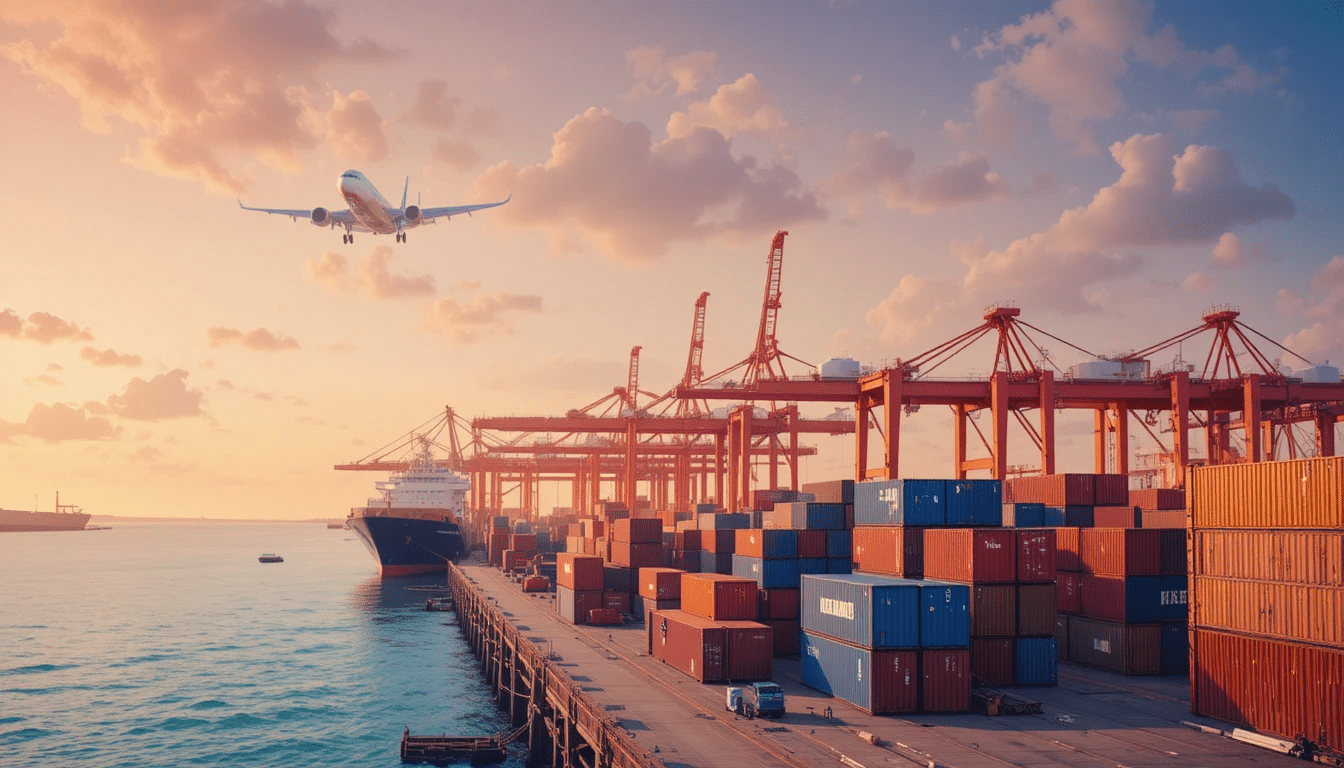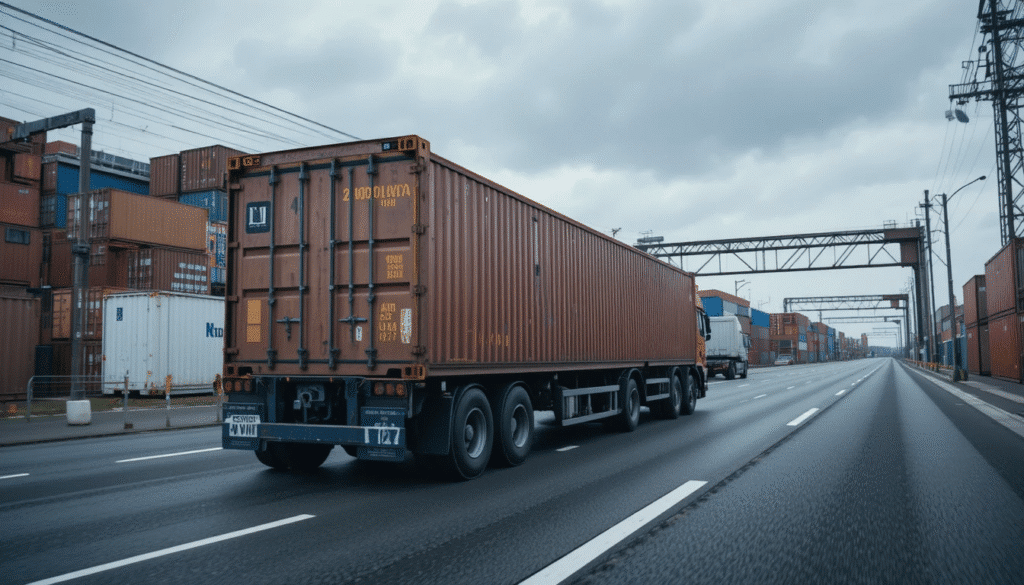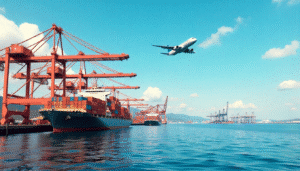Global Logistics in Japan 2025: A Practical Guide to Choosing Reliable, Fast, and Long-Term Freight Partners
By Guanwutong / October 29, 2025
Let us start with a hard truth: picking the wrong freight forwarder can cost you more money and customer relationships than you realize.
One who has been in the freight forwarding business for years has seen companies lose thousands of dollars because they chose a forwarder based on price alone. They picked someone cheap. Someone who seemed to have a global network. Someone who promised fast delivery.
But when things got complicated—when a shipment to Japan got delayed, when customs paperwork had errors, when the customer couldn’t receive their goods on time—suddenly that low price didn’t matter anymore. The damage was done.
The truth is, shipping to Japan isn’t like shipping anywhere else. Japan’s market is demanding. Your customers expect precision. Japanese customs are strict. And if you make mistakes, you pay penalties—not just in money, but in lost customer trust.
This is why you need more than just a shipper. You need a real partner. Someone who understands the problems you’re actually facing. Someone who has solved these problems before. Someone you can trust with your business month after month.
In this guide, I’m going to show you exactly what problems companies run into when shipping to Japan. More importantly, I’m going to explain what separates a good freight forwarder from a great one. And I’ll show you a real example of how working with the right partner completely changed a client’s supply chain.

1. Unstable Shipping Schedules and Missed Deadlines
The Problem You’re Facing
Let’s say you have a shipment ready to go to Japan. You contact your freight forwarder and get a quote. They tell you the ship leaves on the 15th. Great. You plan everything around that date—you tell your customer when they’ll receive their goods, you schedule production, you line up payment terms.
Then the 15th comes and goes. The ship was delayed. Nobody told you. Now it leaves on the 18th. Your customer is angry. Your production is disrupted. If you’re dealing with a Japanese buyer who operates on “Just-in-Time” (JIT) manufacturing, you’ve just halted their production line.
This happens because many forwarders don’t have reliable shipping connections. They’re booking space whenever they can find it. They don’t have stable relationships with shipping lines. They’re reactive, not proactive.
Why This Matters
According to data from Japan’s Ministry of Economy, Trade and Industry, over 60% of Japan’s manufacturing partners operate on JIT schedules with less than 24-hour tolerance windows. That means if you’re late by even a day, you’re creating serious problems for your customer.
Penalties aren’t just financial. You damage your relationship. Your customer starts looking for other suppliers. You lose repeat business.
The Solution: Deep Shipping Partnerships
A reliable freight forwarder doesn’t just book a random shipping line. They have real, long-term relationships with specific carriers. They understand which shipping lines have stable schedules to Japan. They know which ones prioritize reliability.
They also maintain detailed records. They know exactly when ships depart, how long the voyage takes, and what could cause delays. They can give you honest timelines—not optimistic ones.
When you work with a forwarder who has these partnerships, your shipping becomes predictable. You can plan around it. Your customer can plan around it.
For any questions, feel free to contact GWT Shipping. Our team will provide professional, standards-compliant advice tailored to your specific needs.
2. Transparent Pricing That Actually Makes Sense
The Problem You’re Facing
You get a quote from your freight forwarder. It says: “$2,500 to ship to Tokyo.”
That’s the whole quote. Just one number.
Then, when the shipment arrives, you find out about:
Additional port fees
Customs brokerage charges you didn’t know about
Taxes and duties calculated differently than expected
Insurance costs
Handling fees at the warehouse
Suddenly, that $2,500 shipment cost $3,200. You’re shocked. Your customer is upset. Your profit margin just disappeared.
This happens because many forwarders quote a price that looks good, then make money on the “hidden” charges. It’s a bait-and-switch, even if they don’t mean it to be.

Why This Matters
When you can’t predict your shipping costs accurately, you can’t price your products correctly. You can’t calculate your profit margins. You’re flying blind.
If you’re selling to Japan through an e-commerce platform or to a B2B customer, you need to know your landed cost per unit. You need to know exactly what you’re paying to get that product from your factory in China to your customer’s door in Japan.
The Solution: Itemized, Transparent Quotes
A professional forwarder gives you a quote that breaks down every cost:
Freight (sea or air)
Origin charges (pickup, documentation, export customs)
Destination charges (port fees, warehouse handling, customs brokerage)
Duties and taxes (calculated based on your product’s HS code)
Insurance
Any other charges
You see exactly where your money is going. You can compare different forwarders fairly. You can calculate your true cost per unit.
Better yet, a good forwarder explains what each charge is for. They help you understand why the cost is what it is. If there’s a way to reduce costs, like consolidating multiple shipments, they tell you.
This kind of transparency builds trust. It also helps you make better decisions about your supply chain.
If you want to learn more about shipping costs and times from China to Spain, you can read:

Discover how Chinese freight forwarders optimize global logistics in Japan, balancing time, cost, and compliance. Learn practical solutions for JIT delivery, DDP shipping, customs clearance, and Japanese e-commerce fulfillment.

Take Control of Your Schedule! Reduce delays and ensure reliable delivery from China to Japan. China-Japan Shipping (2025): Air 3-5 days, Sea 8-15 days.
Why This Matters
Japan Customs doesn’t mess around. They’re efficient, but they’re thorough. If something in your documentation is wrong, even something small, they will catch it. And they will delay your shipment until it’s fixed.
For certain product categories (food, cosmetics, electronics with batteries, medical products), you need specific licenses and documentation. If you don’t have these lined up before you ship, you’re setting yourself up for delays and potential fines.
The Solution: Pre-Clearance and Professional Customs Expertise
A good forwarder handles customs like this:
First, they review your documentation before you even ship. They check your HS code. They verify that you have all necessary licenses (for example, Japanese Ministry of Health, Labour and Welfare approval for certain products). They make sure your invoice, packing list, and product description all match up perfectly.
Second, they use Japan’s NACCS system (Nippon Automated Cargo and Port Consolidated System) to submit your paperwork for pre-clearance while your cargo is still on the water. This means customs can review everything before you arrive. When your container lands, it can be cleared quickly, sometimes within hours.
Third, they have relationships with licensed Japanese customs brokers. These brokers understand Japanese customs regulations in detail. They know how to handle different product categories. They know what could trigger an inspection and how to prevent it.
This kind of professional handling means you get through customs faster. You avoid delays. You avoid fines. Your customer gets their goods on time.
4. Language and Customer Service Barriers
The Problem You’re Facing
Your customer in Japan needs to know where their shipment is. They have a question about the delivery date. They want to know if they can send something back.
But your freight forwarder doesn’t speak Japanese. Communication goes through you as a middleman. It’s slow. It’s complicated. Your customer is frustrated because they have to explain everything twice—once to you, once to the forwarder.
Or worse, your forwarder tries to communicate directly with your Japanese customer, but there’s a language barrier. Something gets lost in translation. Your customer feels like their needs aren’t being taken seriously.
This problem gets even bigger when you need to handle returns. A Japanese customer sends something back. Now you need reverse logistics. You need a warehouse in Japan to receive the return. You need to inspect it. You need to ship it back to China. This whole process is confusing if your forwarder doesn’t speak the language or understand Japanese business culture.

Why This Matters
Japanese customers expect professional, polite service. They expect to be able to communicate in their own language. If your forwarder can’t provide this, your customer feels disrespected.
Returns are also a huge part of e-commerce in Japan. Japanese law protects consumer returns pretty strongly. If you’re selling to Japan and you can’t handle returns professionally and quickly, you’ll lose customers.
The Solution: Japanese-Language Service and Local Expertise
A professional forwarder who specializes in Japan has a team that speaks Japanese. They can communicate directly with your customers. They understand Japanese business culture and etiquette. They know how to handle customer service the way Japanese customers expect.
They also manage returns professionally. They have relationships with warehouses in Japan that can receive returns. They inspect returned goods. They consolidate them and ship them back to China in bulk (much cheaper than individual returns). They handle all the paperwork and customs documentation for the return shipment.
This kind of service keeps your Japanese customers happy. It also reduces your costs on returns because you’re consolidating them instead of shipping them back individually.

5. Lack of Visibility and Data to Make Better Decisions
The Problem You’re Facing
You don’t actually know where your shipment is. You have to email your forwarder. They respond a few hours later with an update. You feel like you’re always one step behind.
And even when you get updates, the information is vague. “It’s in the warehouse.” “It’s cleared customs.” But you don’t have actual data. You don’t know your average transit time. You don’t know how often shipments are delayed. You don’t know if you’re making money on the Japan route or losing it.
Without this information, you can’t make smart decisions about your supply chain. Should you use sea freight or air freight? Should you invest in a warehouse in Japan? Are your customers happy with delivery times? You don’t have the data to answer these questions.
Why This Matters
In today’s business world, data is everything. Your competitors are probably using data to optimize their supply chains. They’re tracking metrics. They’re identifying problems and fixing them. If you don’t have this visibility, you’re at a disadvantage.
Also, if you’re selling to Japan through a platform like Amazon or Rakuten, these platforms track delivery performance. If your delivery times are slow or inconsistent, they’ll lower your ranking. You’ll lose sales.
The Solution: Digital Tracking and Data-Driven Insights
A modern forwarder gives you a digital tracking portal. You can log in anytime and see exactly where your shipment is. You see real-time updates. You see which stage it’s at—is it in the warehouse, in customs, on the ship, arriving at the port?
Better forwarders also provide data. They give you reports on:
Average transit time
On-time delivery rate
Customs clearance time
Common delays or problems
Cost breakdowns
With this data, you can make better decisions. You can see if sea freight is actually cheaper when you factor in faster turnaround. You can see if investing in a Japan warehouse would improve your delivery times. You can identify problem areas and work with your forwarder to fix them.
Case Study: How GWT Shipping Solved Everything at Once
Background:
A trading company in Guangzhou was exporting petroleum resin to Tokyo. They shipped full 20-foot containers, but their forwarder kept failing them. Schedules were unstable, documents had errors, and customs rejections caused delays. The Japanese buyer lost trust, and the business was at risk.
By the time they came to GWT Shipping, it was urgent. The shipment had to reach Tokyo by the 20th for a letter of credit deadline, but it was already the 10th. Their old forwarder said it couldn’t be done.
Our Solution:
We took over immediately.
We reviewed shipping schedules and chose SITC, a partner line known for reliable service and guaranteed space. A vessel departing on the 14th could meet the deadline.
Then came another problem: the factory staff fell ill and couldn’t palletize the goods. Instead of waiting, we said, “Send the cargo to our Shekou warehouse, we’ll handle it.” Our team worked overnight, palletized and labeled everything, and loaded the container on time.
Meanwhile, our customs team double-checked all documents and filed early. The container cleared smoothly and was loaded without delay.
Because the transit to Tokyo takes only three days, we expedited the bill of lading and arranged a certificate of origin, allowing the buyer to claim tax benefits in Japan.
The Result:
the cargo arrived on time, the letter of credit was honored, and the crisis was solved. Today, this customer ships with us every week, seven 20-foot containers and one 40-foot container to Tokyo, running like clockwork.
We didn’t just move cargo. We solved problems, acted fast, and communicated clearly. That’s what separates a good forwarder from a great one.

6. The Four Solutions That Actually Work
Based on our experience with customers like the one above, there are four main service models that solve the problems companies face with Japan shipping:
Model 1: Sea + Overseas Warehouse (JIT Buffer)
Ship your goods by sea to a warehouse in Japan. This is cheap and reliable. Then, when customers order, you fulfill from the Japan warehouse. This gives you fast delivery to customers (1-2 days), perfect for e-commerce. You also handle returns easily because customers send them to your Japan warehouse.
Model 2: Air Express (Speed Model)
If you need goods in Japan fast—for a product launch, to restock a hot item, for urgent B2B orders—you use air freight. It costs more, but GWT Shipping has blocking agreements with airlines, so we can get space even during peak seasons. With NACCS pre-clearance, goods clear customs within hours of landing.
Model 3: DDP (All-in-One)
We quote you a single price that includes everything: freight, customs, taxes, duties, delivery to the customer’s door. You know your total cost. Your customer doesn’t get surprised by extra charges. It’s simple.
Model 4: Localization Service
Japanese-language customer service. Professional return handling. Compliance with Japanese regulations. Local warehousing if you need it.
Most companies use a combination of these. For example: sea freight + overseas warehouse for regular shipments, but air freight during busy seasons.
Conclusion
Shipping to Japan is complex. You need:
- Stable shipping schedules you can count on
- Transparent pricing with no hidden charges
- Professional customs handling that gets you through clearance fast
- Japanese-language service your customers can trust
- Digital tracking so you know what’s happening
- A partner who solves problems, not just moves boxes
The good news? These aren’t luxuries. They’re the baseline for a professional forwarder who specializes in Japan.
When you work with a partner like GWT Shipping that understands the Japan market, that has real partnerships with shipping companies and Japanese customs brokers, that invests in local warehouses and Japanese-speaking staff—everything gets easier.
Your supply chain becomes predictable. Your customer experience improves. Your costs stay under control. You can actually grow your business instead of managing crises.
That’s the difference between shipping to Japan and succeeding in Japan.
If you’re serious about the Japanese market, it’s time to find a forwarder who’s serious about helping you win there.
FAQ
Japan has strict customs (they’re efficient but thorough), high expectations for on-time delivery (JIT culture), and demands Japanese-language service. The supply chain is also fast-moving—you have 3-4 days of sea freight, so you need to be organized. Companies that ship to Japan usually need a forwarder who understands these specific challenges.
Shipping companies specialize in moving boxes. Forwarders specialize in solving problems. A forwarder handles customs, gets the best rates through partnerships, manages warehouses, arranges last-mile delivery, and takes responsibility if something goes wrong. A shipping company just loads you on a boat.
Sea freight takes about 3-4 days. Air freight takes about 1-2 days. But air freight costs 5-10 times more per kilogram. So it only makes sense for high-value goods or time-sensitive shipments. For most products, sea freight + a warehouse in Japan is the best option financially.
It lets customs review your paperwork before you arrive. Instead of customs inspecting your container when it lands (which can take days), it’s already cleared. You save days. You pay less in demurrage fees. Your customer gets their goods faster.
Not necessarily. But if you ship regularly to Japan, a warehouse saves you money. You ship by cheap sea freight. Goods sit in the warehouse. When your customer orders, you deliver locally (fast and cheap). You also handle returns from one place. The math usually works out in your favor if you’re shipping regularly.
With DDP (Delivered Duty Paid), you pay one price and we deliver to your customer’s door. You know your total cost. Your customer doesn’t pay extra. With other models, your customer might pay import duties or taxes when they receive the goods—they don’t like that. DDP is more customer-friendly.
Ask them for a list of customers who have shipped to Japan with them. Ask for references. Ask about their shipping partnerships—do they have direct relationships with specific shipping lines, or do they book space wherever they can find it? Ask about their warehouse in Japan—do they own it or rent it? Professional forwarders are happy to answer these questions.
Missed deadlines cost you customers. Documentation errors cost you time and money. Poor customer service costs you your reputation. A company might save $200 by choosing a cheap forwarder, but then lose $2,000 in delayed shipments or lost customers. Choose a reliable forwarder. The cost difference is usually small. The value difference is huge.
Ready to talk about your Japan shipping needs?

